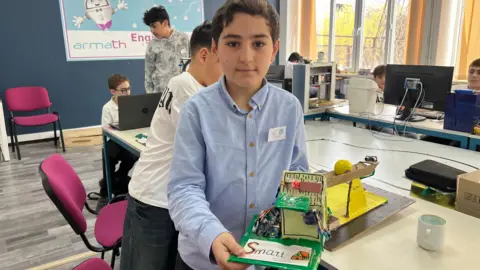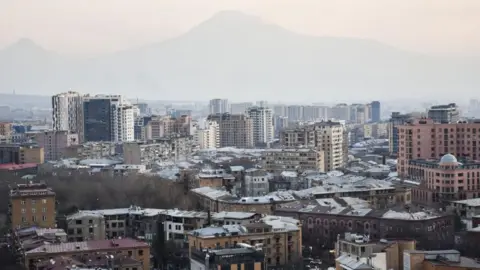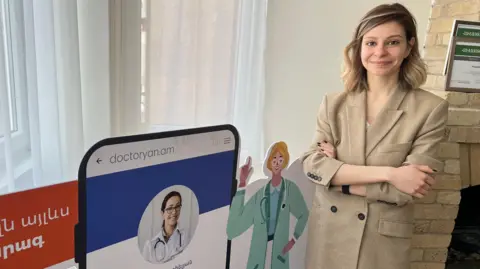Physical Address
304 North Cardinal St.
Dorchester Center, MA 02124
Physical Address
304 North Cardinal St.
Dorchester Center, MA 02124

BBC correspondent South Caucaso
 BBC
BBCIn Armenia Tech, education begins early.
In a typical three -story state school in the suburbs of Ereván, the capital Armenia, Slavik, nine, is demonstrating its invention, a box with three LED lights.
“He has learned how to control it and the programming language. You can see that the code is written by him,” says Maria, the 21 -year -old technology coach who leads the class.
Together with them, Eric and Narek, 14, show their intelligent greenhouse model that monitors the temperature and controls fans automatically through a mobile application.
Other children enthusiastically show their inventions: games, robots, applications and intelligent home projects.
Arakel, eleven -year -old, holds his cardboard model from a house with a retractable tader.
“I have made my mother’s work easy, one part of the device is placed on the ceiling and another is an engine,” he says. “When it rains, the line goes under the ceiling to keep the clothes dry.”
These young inventors have attended engineering laboratory classes where they learn programming, robotics, coding, 3D modeling and more.
The program began in 2014, and is called Armath, which translates into English as “root.” Today there are 650 Armath laboratories in Armenian schools.
The initiative was established by a business organization called the Union of Advanced Technology Companies (UATE), which represents more than 200 high -tech Armenian companies.
“The vision is that we want to see Armenia become a power of the technology center that offers the greatest values to Armenia and the world,” says Sarkis Karapetyan, executive director of Uate.
In his spacious open plant office in Ereván, he says that there are now around 4,000 technological companies in Armenia.
 Getty images
Getty imagesARMATH is part of the UATE education and workforce development program. Karapetyan says that the program is the most successful public-private association in the country.
“We collect the capital spending of the private sector, we go to schools and establish the Armath laboratories, we donate the team,” he says. “And the Government, the Ministry of Education gives us a budget of $ 2 million (£ 1.5m) annually to pay the salaries of the coaches.”
Now there are more than 600 coaches and 17,000 active students.
“The goal is that 5,000 of the most talented children decide to become engineers every year,” says Karapetyan.
Armenia is a country without coast of 2.7 million people, the smallest in the southern region of Caucasus, and its borders with Azerbaijan and Türkiye neighbors have closed for decades due to unresolved territorial disputes.
Unlike its neighbors, Armenia has no natural resources or access to the sea. But throughout the Soviet era it had been a center of mathematics and computer science.
In 1956, the Ereván Mathematical Machine Scientific Research Institute was established in Armenia and in 1960 he had developed two first generation computers.
Today, the country is taking advantage of its legacy with the ambition to transform into the technological power of Caucasus.
And there has already been some success. Picart, a website and application of photos and videos with AI, was launched in Armenia in 2011. Today, the company of the same name, which has double headquarters in Ereván and Miami, is valued at $ 1.5 billion.
Krisp, which manufactures audio processing software, and the Titan service, which provides commercial software, are other Armenian success stories.
Meanwhile, an annual report says that Armenia is the best country in the Las Caucus region to launch a company, putting it in 57th place worldwide. This compares with Georgia in position 70, and Azerbaijan in 80.
 Getty images
Getty imagesA critical factor to promote the technological development of Armenia is the Global Diaspora of the Nation: about 75% of the estimated Armenians of the world and the people of Armenian ancestry live elsewhere.
This world community provides important connections, especially in the United States technology industry. In the United States there are up to 1.6 million people of Armenian descent, focused on California.
Samvel Khachikyan, is Smartgate programs director, a Risk capital firm based in California and Armenia that focuses on technological investments.
He says that if he observes the 500 best companies in the US.
Khachikyan explains how his company helps Armenian entrepreneurs establish operations in the United States.
“Imagine a new Armenia company, two young people who decide to go to the United States to try to operate there, have no connections, or knowledge about culture how it works.
“It will be difficult, very difficult. We are helping them, it is like the launch of the rocket, the first seconds are the most difficult.”
Smartgate takes Silicon Valley and Los Angeles to an intensive network with the main US companies and investors.
But many new Armenian companies first prove their products in their local market.
Irina Ghaaryan, is the founder of an application called Dr. Yan who is changing how Armenians access medical care by allowing them to reserve quotations more easily with doctors.
Mrs. Ghaaryan previously worked on products and web design when, helped by the fact that she comes from a family of doctors, she identified a gap in the market. “Patients could not find the right doctors, and doctors suffered from endless calls.”
The application operates in a subscription model, with doctors who pay to appear on the platform, and there are plans to expand.
“We are growing at least 25% income month by month,” adds Mrs. Ghaaryan. “We are almost even in Armenia and that gives us strength to begin to expand to other markets, such as Uzbekistan.”

Armenian’s technological ecosystem received an unexpected impulse in 2022 after the invasion of Ukraine in Russia. Thousands of specialists in Russians left their country, and many decided to settle in Armenia.
Meanwhile, the United States squirrel manufacturing giant Nvidia moved his Russian office to Armenia.
Vasily is a Russian Ti consultant who moved to Armenia in 2023. “Armenia was the most friendly for the people of Russia to help them move, adapt, etc.,” he says.
He estimates that the Russian IT community in Armenia now totals 5,000 to 8,000 people. It has been said that this influx has filled crucial skills gaps in the technological sector of Armenia, in areas such as data processing, cybersecurity and financial technologies.
However, Vasily says that Armenia can be expensive and that the country needs to reduce the tax burden of IT companies if they want them to stay in the country.
However, general optimism remains high over the technological future of Armenia. Samvel Khachikyan expects the Boom sector. He points out the Titan service, which floated in the New York Stock Exchange last December, and now is worth more than $ 10 billion.